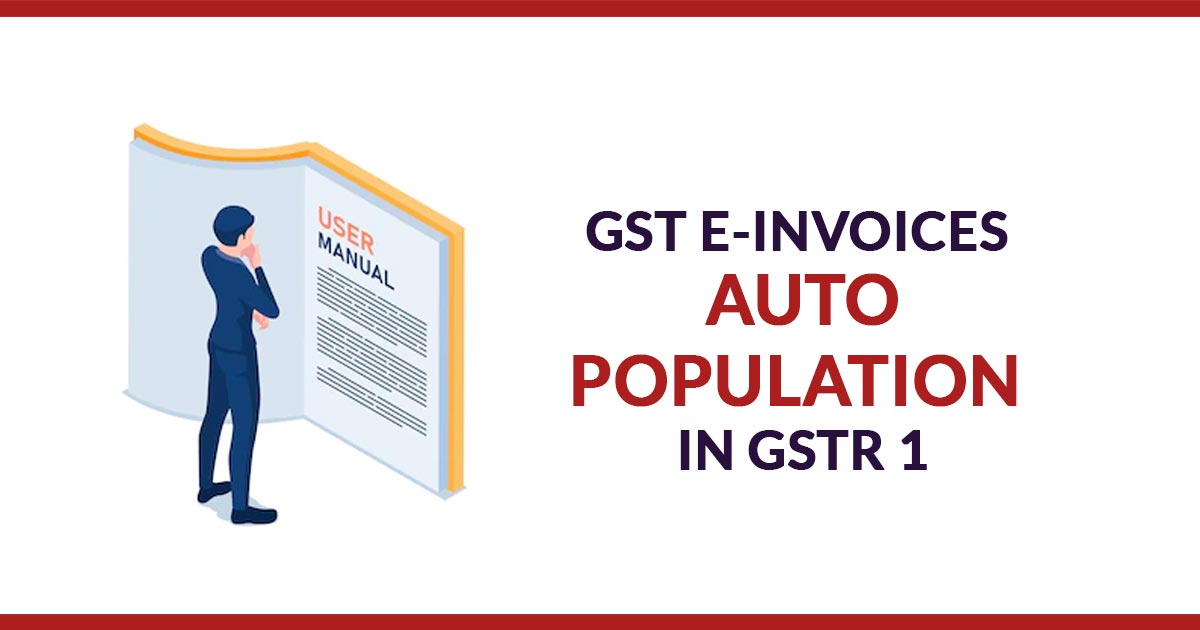
Generation of e-invoice is essential for specific classes of the assessee as mentioned by the government.
The same assessees are needed to make and provide their e-invoices by reporting their invoice data in the mentioned format and reporting that on the Invoice registration portal (IRP). Invoices notified on IRP are provided with the unique invoice reference number (IRN). the documents like (invoices, debit notes, credit notes) notified on the IRP are then transmitted electronically to the GST system and are auto-populated in the corresponding tables of GSTR-1.
How Many Documents are Reported? Invoicing and Auto-Filling Take How Long?
The documents like invoices, debit notes, credit notes are reported on the IRP* are transmitted electronically to the GST system two days post to the generation and are auto-populated in the individual tables of the GSTR-1 of these assessees.
Records that Are Auto-populated Appear Where?
The said auto-populated documents appear as saved records in GSTR-1 of the assessees, with the source of the document prescribed as ‘e-invoice’ and IRN information also prescribed with respect to every record.
What Happens to the Document (Invoice, Debit Note, Credit Note) Submitted on the IRP?
The e-invoice would not be auto-populated in any further GSTR-1. The Excel file comprising the GST e-invoice information can still be downloaded from the GSTR-1 dashboard for the tax duration to which the document invoice, debit note, or credit note belongs.
How to Interpret the Result of a Taxpayer Who Manually Enters a GSTR-1 Document (Invoice, Debit & Credit note) on the IRP?
The data inserted manually would not be overwritten, despite when the GSTR-1 is not being furnished. The Excel file comprises e-invoices information and would be downloaded via the GSTR-1 dashboard of the tax duration where the document (invoice, debit note, credit note) belongs. Since the document already exists in GSTR-1 and it is not auto-population in GSTR-1 from IRP, a message for the same would be specified in the Excel file with respect to the mentioned documents.
Example: Invoice No 001/2022 dated has been inserted manually in GSTR 1on 10th December 2021 (before the due date, i.e 20th December 2021) and is notified on Invoicing Reporting System on 12th December 2021. The same invoice that is inserted manually would not be overwritten.
Invoicing Under GST Cancellation via the IRP*:
Documents notified before on the Invoice Registration Portal (IRP) would be revoked within the mentioned duration on IRP. on the revocation, the cancellation data goes to the GST system, and all the cancelled documents appear as saved documents in the GSTR-1 are deleted from the GSTR-1. The status of the document would be uploaded in the Excel file, from valid to cancelled.
How Do You Format GST E-Invoice Data in Excel?
Another facility of consolidated download of all documents auto-populated via Invoice Registration Portal (IRP) is produced available in the GSTR-1 dashboard. The same Excel file will be available on the GSTR-1 dashboard towards the tax duration to which the document (invoice, debit note, credit note) belongs. Through the download details from the e-invoice (Excel)’ button on the GSTR-1 dashboard, the file would be downloaded.
Excel Format Contents
- Invoice Reference Number (IRN) – 64 string hash
- Date of Invoice Reference Number (IRN date)
- e-invoice Status – Valid / Cancelled
- Date of auto-population/deletion on cancellation – Date of auto-population into GSTR-1 when the valid IRN, or the Date of deletion in the cancelled IRN, according to the case.
- Error in auto-population/ deletion – Error description, if any.
Can You View the History of the GST e-invoice Download?
The assessee would use the link ‘e-invoice download history’ to see the list of the last 5 downloaded files.
Supplies that are Auto-populated in E-invoicing Under GST
- The taxable outward supplies are made to enroll the individual along with the reverse charge mechanism.
- Credit and debit notes were given to the registered and unregistered persons.
- Export Supplies.
Things to be Acknowledged
Explanation: The tax period of GSTR-1 where the e-invoice shall be auto-populated would be according to the Document Date, irrespective of the date on where the document (invoice, debit note, credit note) was notified on the IRP & the IRN was generated.
Example: Invoice No 001/2022 dated 25th October 2021 is notified on Invoice Reporting Portal on the date 10th November 2021. The e-invoice information will be shown in GSTR 1 for the month of October and not for the month of November.
- *IRP- Invoice Registration Portal
- *IRN- Invoice Reference Number